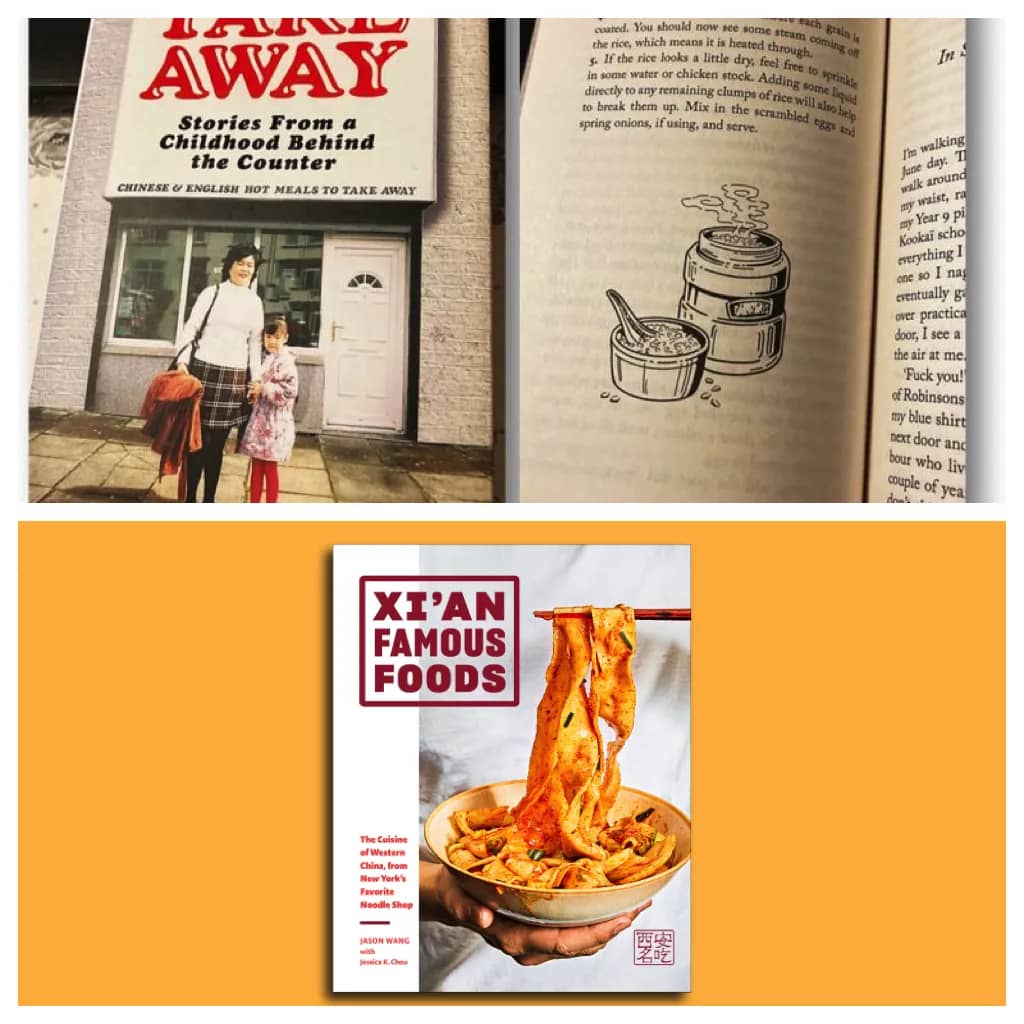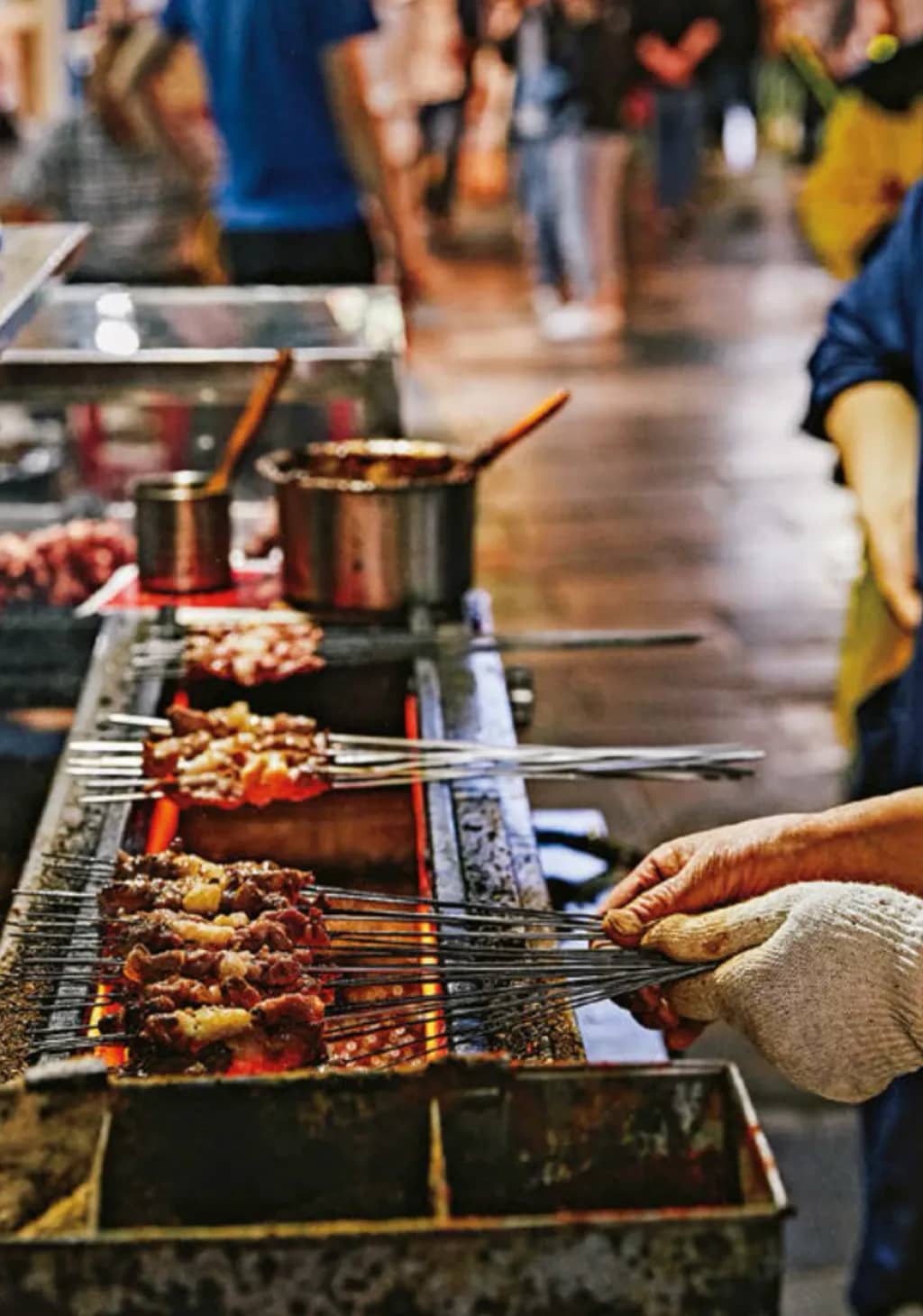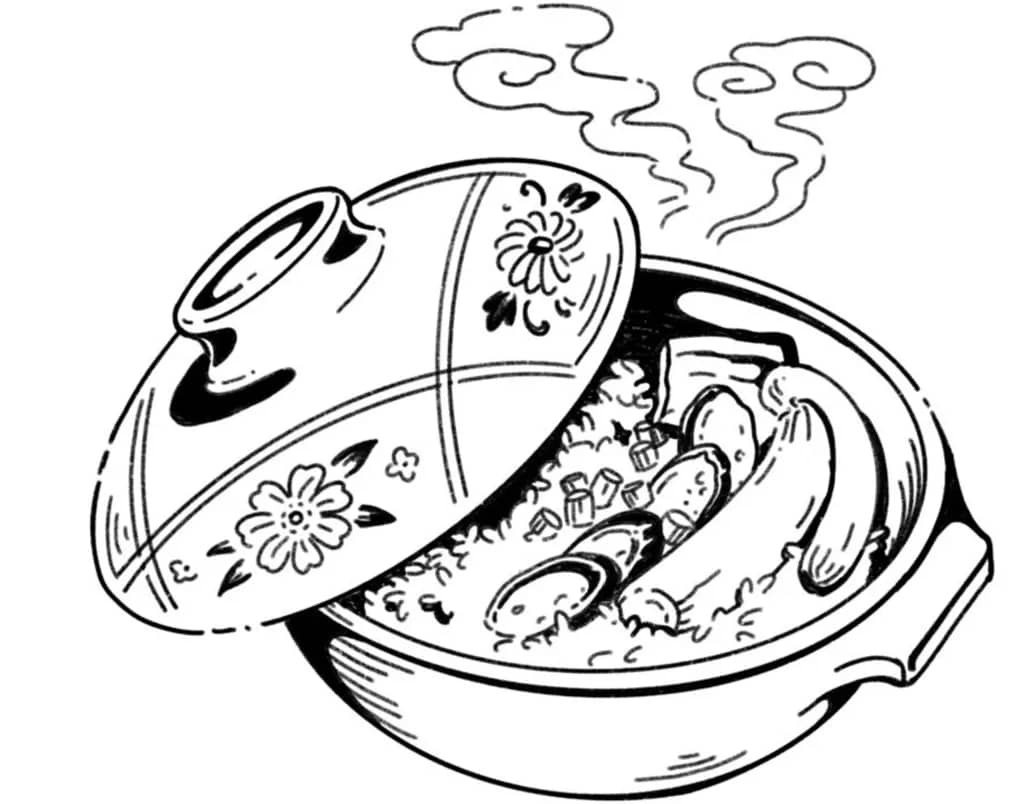An excerpt from “Xi’an Famous Foods: The Cuisine of Western China, from New York’s Favorite Noodle Shop” by Jason Wang reminds me of Angela Hui in “Takeaway”. They grew up more than 3,000 miles apart. The latter from Beddau (which means ‘graves’ in Welsh), a former mining village in the South Wales Valleys, the former from New York via Xi’an, China. But united in purpose by parent’s who both ran food stores. And their constant struggle to make ends meet and to “fit in”…

Wang:
“These treks to New York became our ritual as well. Every month, we’d brave the traffic and drive three hours to the crowded blocks surrounding Main Street. We’d park the car in the cheaper municipal parking lot (or circle around for thirty minutes to snag free parking if it was a Sunday), go get a six-dollar haircut, grab some Sichuan food, and then battle other shoppers to stock up on the necessities. My family would load up the car with jugs of good soy sauce, pounds of rice, and boxes of black vinegar. We’d grab Pixian bean sauce, dried red chile peppers, lamb, chicken feet, pork belly, the works. Then we’d drive back to our apartment and cook it all up, freeze it, and survive off those dishes for the next four weeks.”
Hui:
“Our first port of call: the cash-and-carry wholesalers. As our car rolls up in an industrial estate in Grangetown – a diverse working-class area with a significant Somali, Asian and mixed-race community – the sky starts to clear up and the sun starts to peek through, as if welcoming us into the city. Global Foods cash-and-carry is a mecca. From the outside, it doesn’t look like much – dark-blue corrugated roof held up by a red steel frame and a giant white ‘Global Foods’ banner with a little globe logo – but on the inside, it’s a different story. Floor-to-ceiling shelves of hyper-organised, neatly labelled products. From jumbo tubs of herbs to multipack tins of sauces and boxes of savoury snacks, you’ll find everything you could possibly need under one roof that comes in catering size and can only be bought in bulk. I feel the full effects of the Alice in Wonderland syndrome, realising my tiny ant-like presence in a vast warehouse packed to the brim with comically large items.”
It seems to me — albeit an outsider — that Chinatowns and these large stores are one place of comfort and safety for immigrants like them? Because it is where they can choose to relax, to take a deep, deep breath whilst seeing many others that look and talk just like them and can there (possibly, this is only my view) more easily have a sense of belonging to or, at least, feel slightly less alienated from, a country that is predominantly not their colour or culture.
Angela went on to become a highly respected writer and editor and food consultant, whilst Jason stayed to carry on his family business and expand it into a bunch of award winning places. Both are cooks. Both books are great.
So, a recipe from each.
From Jason: Spicy Cumin Lamb Skewers 孜然烤羊肉串

“When I was a kid, I didn’t really like eating. I preferred playing with my toys in the sunroom or catching crickets. But that changed when I had my first skewer from the Muslim Quarter’s street market. These were dangerously easy to eat, made with tiny little morsels of lamb, occasionally interspersed with a fatty, juicy piece for extra flavor, all speared onto a thin needle-like skewer. It was smoky, savory, and spicy all at once, sprinkled with Middle Eastern spices and crunchy, coarsely ground cumin seeds. I used to brag about eating sixty to eighty in one sitting—and for a scrawny kid like me, that was a lot. This was the dish I missed the most when I first moved to the States, and learning to re-create it took years. When I finally got around to mastering the flavors at a lakeside barbecue one summer day, I was so happy I almost cried. Note: We use sesame seeds here for the crunch, but if you have whole cumin seeds lying around, feel free to add those in addition to the ground cumin (you can never have too much, in my opinion). Makes 10 skewers”
FOR THE LAMB:
2 pounds (910 g) boneless lamb leg meat
2 tablespoons Shaoxing cooking wine
1 teaspoon salt
½ teaspoon white pepper powder
1 teaspoon Sichuan peppercorns
2 green onions, trimmed and cut into slivers
1½-inch (4 cm) piece fresh ginger, peeled and cut into slivers
¼ medium red onion, sliced
FOR GRILLING AND SERVING:
½ tablespoon coarsely ground cumin
2 teaspoons Red Chilli Powder
Salt
½ tablespoon Roasted Sesame Seeds
TOOLS:
10 bamboo skewers
Robata grill or barbecue
To make the lamb: Cut the lamb into rectangles that are 1 inch (2.5 cm) long and ½ inch (12 mm) thick. In a large bowl, combine the remaining ingredients to make a marinade and add the lamb. Stir well to combine. Cover the bowl with plastic wrap and let sit in the refrigerator for 1 hour. Any longer and you risk over-marinating.
To grill and serve: Skewer the lamb lengthwise onto the skewers, making sure to retain the lamb cut’s shape and keep the meat long and slender. Add 5 leaner pieces and 2 fattier pieces of lamb to each skewer, interspersing the fattier pieces between the leaner pieces. The skewers may be kept refrigerated, covered, before cooking, but for no longer than 2 hours.
Prepare a robata or other grill with charcoal that has turned ashy gray and is smoldering hot but not actively emitting flames.
Set the skewers down on the grill surface and cook for 2 minutes. Flip over and cook for an additional 2 minutes.
When the meat tightens up and oil begins to seep out, it is almost done. At this point, sprinkle half of the cumin, red chili powder, and salt, to taste, on top. Try to get as much on the meat as possible, but it’s okay if a little of the seasoning falls into the grill.
Flip the skewers over and season the other side in the same way. Flip the skewers once more and toast the newly seasoned side for 30 seconds. Cook for about a minute or so more on each side.
Remove the cooked skewers to a plate, sprinkle with the sesame seeds, and serve immediately.
From Angela: Bo Zai Fan 煲仔饭 Claypot rice with lap cheong (Chinese sausage) and lap yuk (Chinese cured pork belly)
“A soothing and satisfying meal before (or during) hectic service that’s effective for feeding many mouths with very little effort. If you want the classic crispy, crunchy rice base, then I’d recommend cooking in a clay pot directly on the hob or an open flame for the best results. If you’re short on time like my mother was on most days, then let the rice cooker do all the work for you, as it’s an ideal ‘leave-and-forget-about-it’ dish. Seeing plumes of steam rise and escape from the pot and breathing in the intoxicating smell of the aromatic, fatty cured meats mixed with the fragrant rice always makes me giddy with anticipation. Sometimes Mum would let me be in charge of the rice paddle and gave me the most important (and fun) task of mixing everything together. It’s an exciting interactive dish to do with kids, where they can see the white rice turn a lovely golden colour as each grain is coated in the sauce.”
Serves: 4 | Prep time: 15 mins | Soak time: 30 mins | Cook time: 12-15 mins

Ingredients:
2 cups (400g) jasmine white rice
2 cups (500ml) water
2–3 links of lap cheong Chinese dried sausage
7.5cm piece of lap yuk Chinese cured pork belly
2 spring onions, diced
For the sauce:
2 tbsp light soy sauce
½ tbsp dark soy sauce
1 tbsp fish sauce
1 tsp sesame oil
1 tbsp Shaoxing wine
¼ tsp sugar
¼ tsp white pepper
Method:
1. Start by washing the rice. Put the rice into a bowl, add enough water to cover, then use your hand to agitate the rice and swirl the grains. You’ll see the water go cloudy; discard the cloudy water, fill up with clean water and repeat at least three times until the water runs clear. Add 500ml of water and soak the rice for 30 minutes. It’s important not to miss the soaking step as this helps the rice cook through evenly.
2. Next, make the sauce. In a small bowl, mix all the sauce ingredients together. Set aside.
3. You can either make this dish in a clay pot or a rice cooker. Place the meat on top of the washed, uncooked rice, press the button, and cook normally. By cooking the meat and rice together, the fat from the meat seeps into the rice.
4. For those using a saucepan or clay pot, bring the rice to a boil on high heat and cover with a lid. Once bubbling, turn the flame down to the lowest setting possible and cook for 12 minutes. Switch off the heat and let the ricestand for 1 minute with the lid still on. Once steamed, take the meat out and slice it.
5. Fluff the rice, return the meat to the rice along with the sauce, spring onions and an extra drizzle of sesame oil. Have fun stirring the rice and make a glorious mess together. Serve with greens or choi or eat as is.